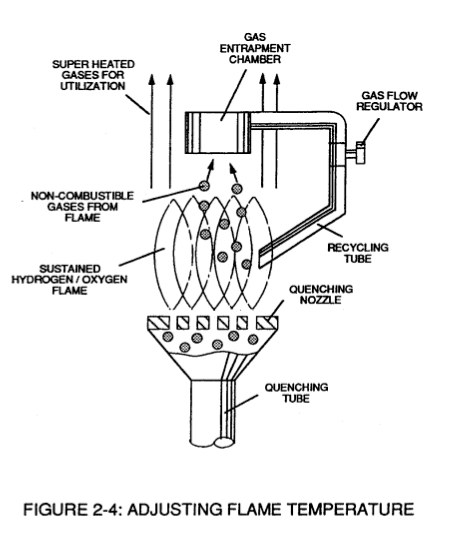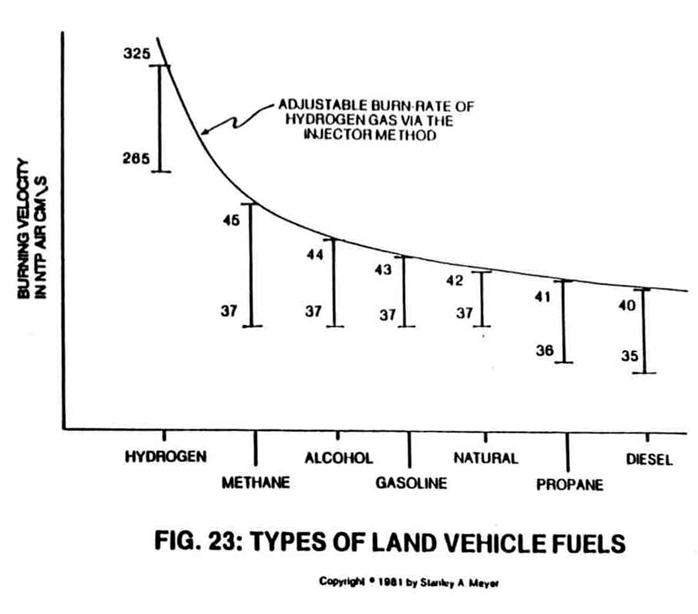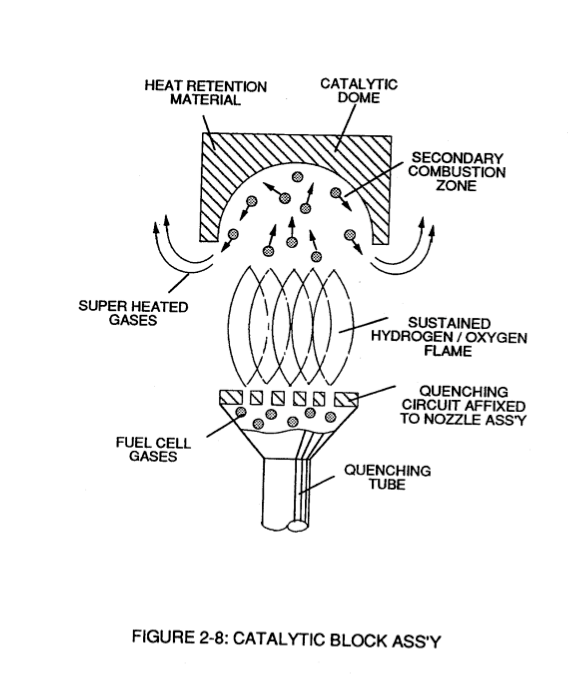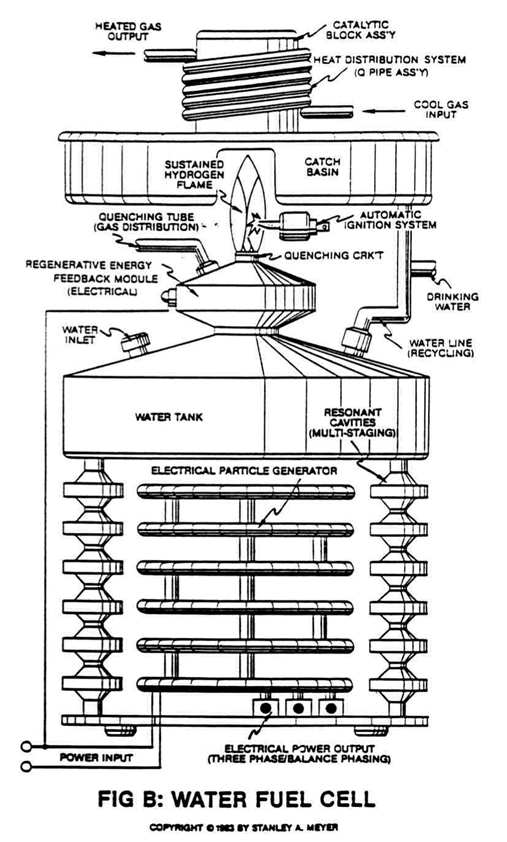Catalytic Block Assembly
Purpose:
To develop and utilize a hydrogen gas reclaim system capable of performing water purification on demand without using chemical filters.
Assembly Stage:
Catalytic Dome Assembly (10/30) positioned on top of and in space relationship to a Quenching Nozzle (20) affixed on top of and to a natural Water Fuel Cell, as illustrated in Figure 24 as to Figures 24SA, Figure 24SB, and 24SC.
| Figure 24SA |
Figure 24SB |
Figure 24SC |
Water condensing unit (40) of Figure (39) is placed over said Dome Assembly (10/30).
 |
 |
NATURAL WATER GASES:
Since the Fuel Cell utilizes voltage to dissociate the water molecule, the Fuel Cell becomes a multi-gas generator, producing hydrogen, oxygen, and ambient air gases (water contains 17% to 19% per volume of ambient air) in a uniform gas-rate. Since water is the gas mixing regulator, the fuel gas ratio is composed of 2 hydrogen atoms to 1 oxygen atom plus 17% to 19% per part of ambient air gases.
The gas mixing ratio remains the same regardless of the gas rate of said Fuel Cell, as so described in Figure 24.
HYDROGEN BURN-RATE CO-EQUALLY NATURAL GAS:
The ambient air gases (composed of non-combustible gases that do not support the burning process) act as a gas-burning modulator that retards the speed at which the hydrogen atoms unite with the oxygen atom during the gas burning process, see Figure 24 again.
The gas mixing ratio of said Fuel Cell automatically adjusts the burn rate of hydrogen gas from 325 cm/sec to 42 cm/sec, co-equating the burn-rate of natural gas, as illustrated in Figure 24 as to Figure Graph 23.
 |
The hydrogen gases support a flame temperature up to and beyond 5,000 degrees F.
To reduce the burn-rate of the hydrogen gas still further to lower flame temperature, simply capture (1) and recycle (2) the non-combustible gases (3) being expelled from said sustained hydrogen flame (9), as illustrated in Figure 24 as to Figure 24SC.
The non-combustible gases are flow-regulated and transferred back into the sustained hydrogen flame and/or added to the fuel cell prior to the gas ignition process.
The gas flow regulator or gas valve (11) can adjust or lower the hydrogen flame temperature below that of burning paper.
This gas modulation process is further used to transport hydrogen gas through conventional gas lines, as shown in Figure 31.
In another application, the gas modulation technique is also used to run a conventional car engine, as illustrated in Figure 22 as to Figure Graph 23.
QUENCHING CIRCUIT:
The Quenching Nozzle (20) of Figure 24SB as to Figure 24SC, Figure 24SA, and Figure 24, prevents spark-back into the Fuel Cell during gas ignition.
| Figure 24SB | Figure 24SC | Figure 24SA |
As the fuel gases (6) enter into, pass through and beyond the quenching circuit (5) of Figure 24SB, the Fuel Cell gases (6) are lengthwise distributed through a small elongated gas port (5) at least smaller than .015 inch diameter but equal to or greater than 1/8 inch length formed by Quenching Disc (7) of Figure 24SB.
The aligned gas atoms located inside this gas passageway (5) alternate regroup to support gas ignition since the non-combustible gas atoms retard the oxygen atom to unite with the hydrogen atoms, see Figure 24SD.
Multiple Quenching Circuits (5a xxx 5n) of Figure 24SB are used to prevent flame-out when the Fuel Cell gases exceed a certain gas velocity.
QUENCHING CIRCUIT RELIABILITY:
A non-oxidizing material such as alumina (a type of ceramic material) is used to form said quenching disc (7) to prevent gas port (5) enlargement due to chemical interaction and/or heat exposure or both.
The nozzle assembly (20) itself acts as a heat sink.
SUSTAINING AND MAINTAINING A HYDROGEN GAS FLAME:
 By simply igniting the Fuel Cell gases (6) expelling from said Quenching Nozzle (20) of Figure 24SB as to Figure 24, a hydrogen/oxygen flame (9) of Figure 24SB as to Figure 24 is sustained and maintained regardless of the gas-rate of said Fuel Cell.
By simply igniting the Fuel Cell gases (6) expelling from said Quenching Nozzle (20) of Figure 24SB as to Figure 24, a hydrogen/oxygen flame (9) of Figure 24SB as to Figure 24 is sustained and maintained regardless of the gas-rate of said Fuel Cell.
Flame projection is achievable beyond six inches while flame temperature is variable up to and beyond 5,000 degrees F.
The modulated gas mixture (6) near each quenching circuit (5) prior to gas ignition (9) helps keep quenching disc (7) cool to the touch.
HYDROGEN LEAKAGE:
To help prevent hydrogen gas leakage due to quenching circuit flame-out (Murphy's law of probability), said quenching circuits (5a xxx 5n) are prearranged in such a way as to allow an adjacent flame (9) to re-ignite the expelling fuel gas.
The overlapping flame pattern (12a xxx 12n) of Figure 24SB as to Figure 24SA also aids the hydrogen burning process by concentrating flame temperature in a centralized area while said anti-spark back technique (quenching circuit) remains intact.
SECONDARY BURNING ZONE:
To ensure total and complete gas combustion during Fuel Cell operations, a Catalytic Dome (10) is placed on top of and in space relationship to said quenching nozzle (20), as so illustrated in Figure 24SA.
The hemispherical-shaped dome (13) performs several functions simultaneously:
- captures and entraps any and all combustible gases that somehow escape the gas-burning process;
- ignites said combustible gases inside said catalytic dome composed of heat-retaining material (like ceramic);
- redirects the burning gases back into the sustained hydrogen flame for continuing burning… superheating the gases for utilization (14).
In actuality, the hemispherical dome (10) of Figure 24SA performs as a secondary combustion zone.
 |
The superheated gases prevent Nitrous Oxide (N2O) formation.
WATER PURIFICATION:
Water purification is now performed in a three-step operation: contaminates in water remain in the Fuel Cell since voltage is used to dissociate the water molecule; the sustained and maintained hydrogen gas flame kills any and all bacteria that attach themselves to the Fuel Cell gases; cooling the superheated gases moving away from the hydrogen gas flame forms water droplets free of contaminates and bacteria.
To accomplish the gas cooling process, a gas condensing assembly (40) is attached to the catalytic block assembly (10/20), as illustrated in Figure 39.
The first stage heat exchanger (15) exposed to said flame temperature (9) heats a cycling gas that enters into and passes through a gas expansion chamber (16).
The expanded gas cools another heat exchanger (17) exposed to superheated gases (14) of Figure 24SA.
The resultant temperature gradient performs the water condensing process.
The gas condensing assembly (40) has no moving parts and is self-regulating as to the flame temperature.
The collected and stored water inside catch basin (18) can be “drained off” for drinking water or re-routed back to the Fuel Cell for hydrogen reuse, as so illustrated in Figure 39 as to Figure B titled “Water Fuel Cell.”
During water recycling, the water molecule is re-exposed to laser energy (Figure 20FB as to Figure 20K) for Energy Charging... duplicating sun exposure.







